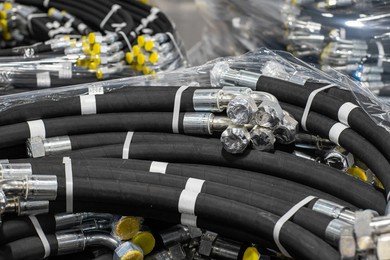Automotive Customized 3/16 NBR Steam Hose
2023-02-24 14:15:50
Steam hoses are specialty rubber hoses used for transporting steam. Steam is a colorless and odorless liquid that can transport large amounts of heat efficiently. Steam is used in many industrial processes. It is used to generate electricity by steam turbines and thermal electric power plants. It is also used as a heating medium in many industrial applications.
These hoses are made from synthetic EPDM rubber. They are designed to withstand high temperatures and can channel wet or dry steam. Steel wire spirals, steel braid reinforcement, and polyester and steel braid reinforcement are resistant to pressure and degrading. However, steam hoses can be damaged by oils, chemicals, or moisture. They should be inspected regularly.
These hoses can be used in oil-resistant areas such as chemical plants, refineries, and other areas that need high levels of oil resistance. The hoses are usually made from a non-flammable material that can withstand steam pressures up to 207degC. There are two main types of steam hoses. One is oil resistant, and the other is non-oil resistant. Non-oil hoses are generally used for cleaning and moisturizing, while oil-resistant hoses are designed for use in more demanding applications such as chemical plants.
Steam is an important and valuable energy source for many industrial processes. It can be used for heating, as a cleaning agent, as a transfer medium, and for a variety of other purposes. It is often used where water is scarce due to its low cost. In the colder climates, low-pressure saturated steam is a common indoor heating source. If you are considering purchasing a steam hose, you must pay attention to the temperature, the amount of pressure, and the operating range. To ensure safety, the hose should be carefully chosen.
NBR is a type of synthetic rubber that has excellent resistance to both heat and water. It is used in gaskets and other products and is one the most popular types. The most popular type of synthetic rubber is Nitrile rubber. It has abrasion and fuel resistance as well as durability and high elasticity. It also has good ozone, weather, and ozone resistance.
NBR is a good choice in non-conductive applications but not for hose covers. The steam's inner layer can absorb water and form blisters. High pressure can cause rubber to deteriorate and leak. The rubber's resistance against oils is increased by having high levels of acrylonitrile, but it also has a lower compression resistance.
Steam hoses are available in flexible and rigid forms. The flexible version can be used at 18 bar pressure while the rigid version can be used at lower pressure. Whether you need a flexible or rigid steam hose, you should look for a manufacturer that offers the appropriate hose size for your application.
High strength synthetic piles are available for pressures up to 20 bar. All steam hoses can have stainless steel inlays. These inlays are resistant to rust and increase safety for the hose.